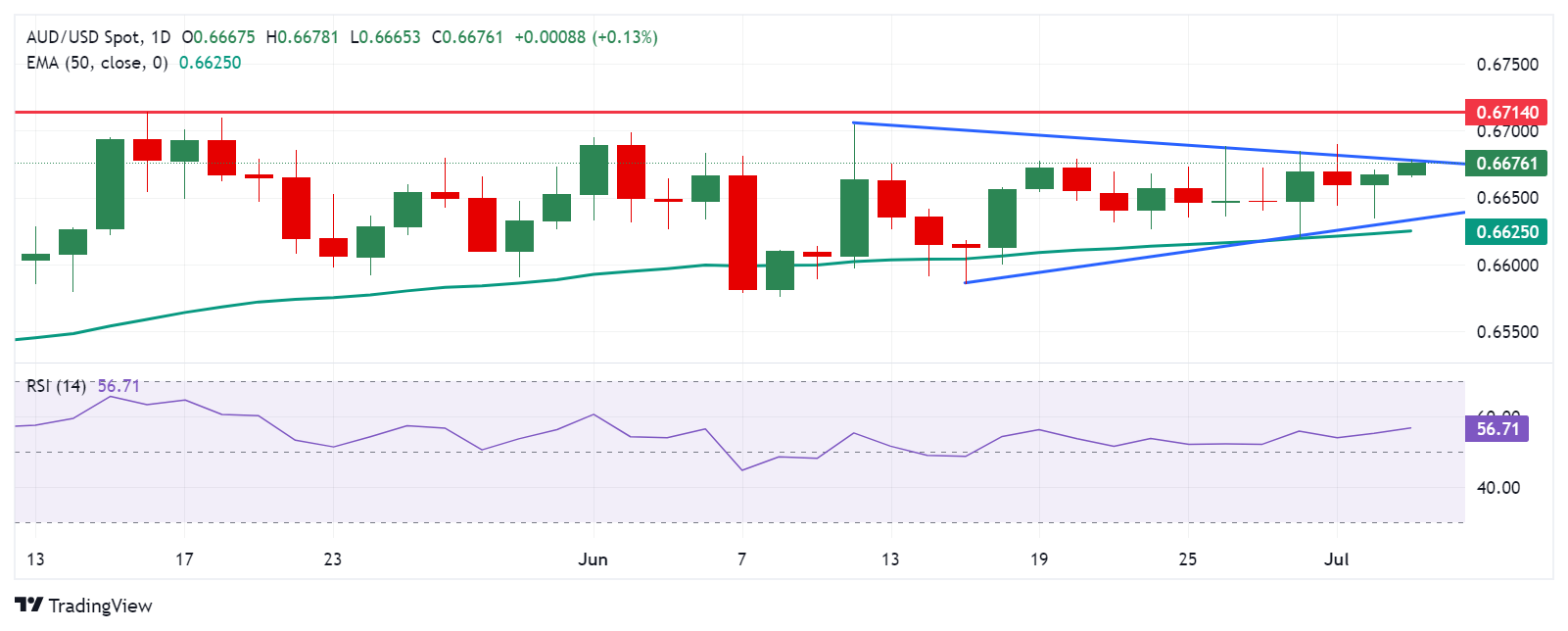- The Australian dollar gained ground following the release of strong economic data on Wednesday.
- Australian retail sales rose 0.6% month-on-month in May, beating both the anticipated 0.2% increase and the previous 0.1% rise.
- Fed Chairman Jerome Powell wants to see more evidence before cutting interest rates.
The Australian Dollar (AUD) continued to gain ground for the second day in a row on Wednesday. This increase is attributed to the Judo Bank Australian Purchasing Managers Index (PMI) figures, which showed a slight improvement in June.
Australia’s retail sales, a measure of consumer spending in the country, rose 0.6% month-on-month in May, up from a 0.1% increase in the previous month. This figure beat market expectations for a 0.2% rise.
The AUD/USD pair is also supported by the weakness of the US Dollar (USD), which is likely due to the fall in US Treasury yields. Traders will look for further direction from the US ADP Employment Change, the ISM Services PMI for June and the FOMC Minutes, all scheduled for release later on Wednesday.
Daily Market Drivers Roundup: Australian Dollar Appreciates on Higher PMI
- Judo Bank Australia’s services PMI rose to 51.2 on a monthly basis, up from 51.0 in the previous month, beating the expected drop to 50.6. Meanwhile, the composite PMI rose to 50.7 on a monthly basis, compared with 50.6 in the previous month.
- China’s services Purchasing Managers’ Index (PMI) fell to 51.2 in June from 54.0 in May, according to the latest data released by Caixin on Wednesday. The market forecast was for a reading of 53.4 in the reporting period.
- Federal Reserve (Fed) Chairman Jerome Powell struck a slightly dovish tone on Tuesday. Powell said the Fed is returning to a disinflationary path. However, Powell wants to see more evidence before cutting interest rates as the U.S. economy and labor market remain strong, according to Reuters.
- Minutes of the Reserve Bank of Australia’s (RBA) June policy meeting, released on Tuesday, said “the board considered that the case for holding rates steady was stronger than that for raising them.” The board stressed the need to remain vigilant regarding upside risks to inflation, noting that data suggested an upside risk to the May Consumer Price Index (CPI).
- The Reserve Bank of Australia (RBA) Commodity Price Index fell 4.1% year-on-year in June, following an upward revision from the previous month’s 6.0% decline. June’s fall marks the mildest deflation in sixteen consecutive months.
- The Melbourne Institute’s monthly inflation index has raised concerns that the RBA could raise interest rates again in August. The index rose 0.3% in June, keeping pace with May, marking the fourth consecutive month of increases and remaining at the highest level since January.
- On Tuesday, Chinese state-run media Securities Daily quoted CITIC Securities’ chief economist as suggesting that the People’s Bank of China (PBOC) may consider measures such as lowering the reserve requirement ratio (RRR) to inject liquidity into the market. Any potential economic changes in China could significantly influence the Australian Dollar (AUD), given the close trade relationship between the two nations.
Technical Analysis: Australian Dollar Holds Above 0.6650
The Australian Dollar is trading around 0.6670 on Wednesday. The daily chart analysis shows a symmetrical triangle, which represents a pause in the trend as traders reach a balance. However, once the price decisively breaks out of the triangle, it will signal a clear directional trend. However, the 14-day Relative Strength Index (RSI) is slightly above the 50 level, indicating a bullish bias.
The AUD/USD pair is likely to test the upper boundary of the symmetrical triangle around 0.6680, followed by the psychological level of 0.6700. Additional resistance is located at 0.6714, the highest level since January.
On the downside, the AUD/USD pair could find key support around the lower boundary of the symmetrical triangle at 0.6630, followed by the 50-day exponential moving average (EMA) at 0.6625.
AUD/USD: Daily Chart
Australian Dollar PRICE Today
The table below shows the Australian Dollar (AUD) exchange rate against major currencies today. The Australian Dollar was the strongest currency against the Japanese Yen.
| USD | EUR | GBP | JPY | CAD | AUD | NZD | CHF | |
|---|---|---|---|---|---|---|---|---|
| USD | 0.02% | 0.00% | 0.08% | 0.03% | -0.10% | -0.02% | 0.05% | |
| EUR | -0.02% | -0.01% | 0.09% | 0.00% | -0.13% | -0.02% | 0.02% | |
| GBP | -0.01% | 0.01% | 0.10% | 0.02% | -0.11% | 0.00% | 0.02% | |
| JPY | -0.08% | -0.09% | -0.10% | -0.07% | -0.20% | -0.11% | -0.07% | |
| CAD | -0.03% | -0.01% | -0.02% | 0.07% | -0.13% | -0.03% | 0.00% | |
| AUD | 0.10% | 0.13% | 0.11% | 0.20% | 0.13% | 0.10% | 0.13% | |
| NZD | 0.02% | 0.02% | 0.00% | 0.11% | 0.03% | -0.10% | 0.03% | |
| CHF | -0.05% | -0.02% | -0.02% | 0.07% | -0.00% | -0.13% | -0.03% |
The heatmap shows percentage changes of major currencies. The base currency is selected from the left column, while the quote currency is selected from the top row. For example, if you choose the Australian Dollar from the left column and move along the horizontal line to the US Dollar, the percentage change shown in the chart will represent the AUD (base)/USD (quote).
Australian Dollar FAQs
One of the most important factors for the Australian Dollar (AUD) is the level of interest rates set by the Reserve Bank of Australia (RBA). Since Australia is a resource-rich country, another key factor is the price of its largest export, iron ore. The health of the Chinese economy, its largest trading partner, is a factor, as is inflation in Australia, its growth rate and the Trade Balance. Market sentiment, i.e. whether investors are betting on riskier assets (risk-on) or seeking safe havens (risk-off), is also a factor, with risk-on being positive for the AUD.
The Reserve Bank of Australia (RBA) influences the Australian Dollar (AUD) by setting the level of interest rates that Australian banks can lend to each other. This influences the level of interest rates in the economy as a whole. The RBA’s main objective is to maintain a stable inflation rate of 2%-3% by adjusting interest rates up or down. Relatively high interest rates compared to other major central banks support the AUD, and the opposite for relatively low ones. The RBA can also use quantitative easing and tightening to influence credit conditions, with the former being negative for the AUD and the latter positive for the AUD.
China is Australia’s largest trading partner, so the health of the Chinese economy greatly influences the value of the Australian Dollar (AUD). When the Chinese economy is doing well, it buys more raw materials, goods and services from Australia, which increases demand for the AUD and drives up its value. The opposite occurs when the Chinese economy is not growing as fast as expected. Therefore, positive or negative surprises in Chinese growth data often have a direct impact on the Australian Dollar.
Iron ore is Australia’s largest export, worth $118 billion per year as of 2021 data, with China being its main destination. The price of iron ore can therefore be a driver of the Australian dollar. Typically, if the price of iron ore rises, the AUD rises as well, as aggregate demand for the currency increases. The opposite occurs when the price of iron ore falls. Higher iron ore prices also tend to lead to a higher probability of a positive trade balance for Australia, which is also positive for the AUD.
The trade balance, which is the difference between what a country earns from its exports and what it pays for its imports, is another factor that can influence the value of the Australian dollar. If Australia produces highly sought-after exports, its currency will gain value solely because of the excess demand created by foreign buyers wanting to purchase its exports compared to what it spends on buying imports. Therefore, a positive net trade balance strengthens the AUD, with the opposite effect if the trade balance is negative.
Source: Fx Street
I am Joshua Winder, a senior-level journalist and editor at World Stock Market. I specialize in covering news related to the stock market and economic trends. With more than 8 years of experience in this field, I have become an expert in financial reporting.





.jpg)


